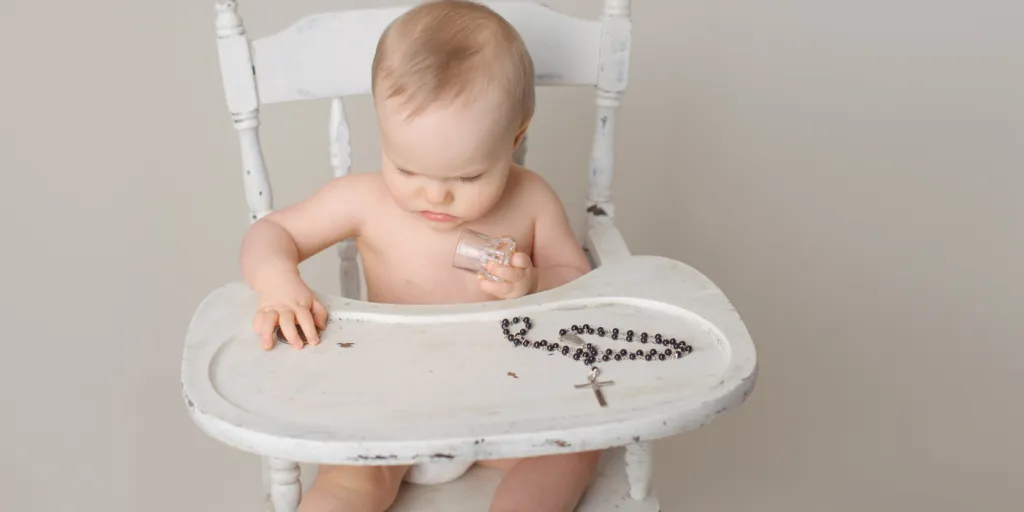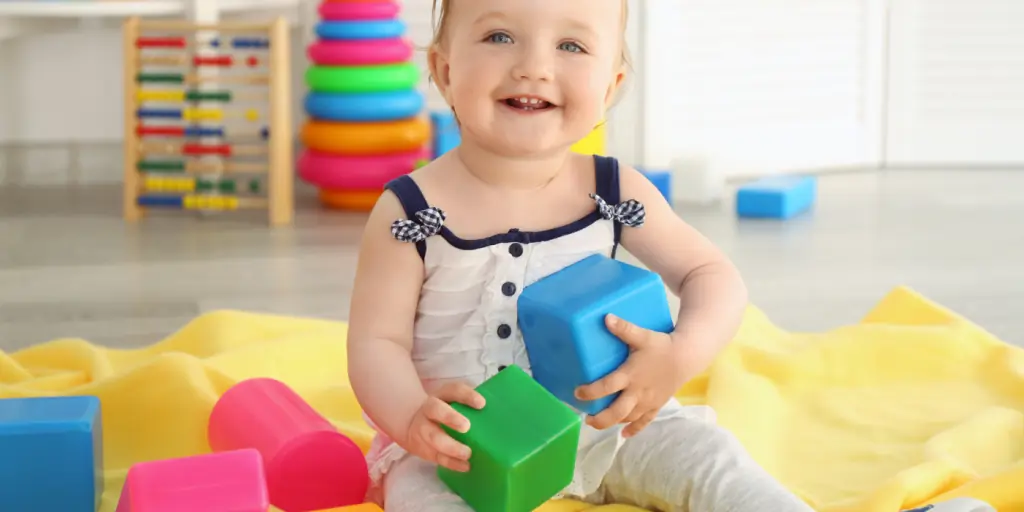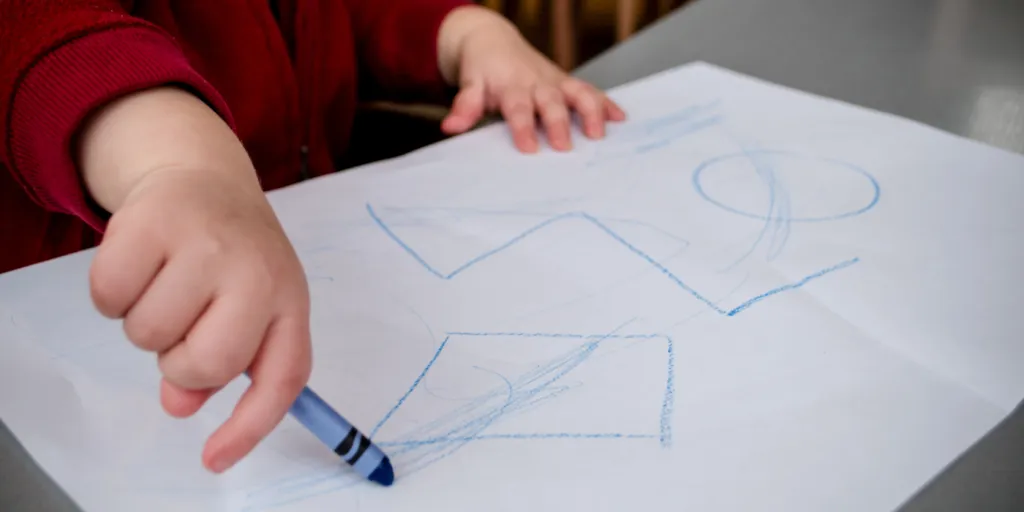As parents or caregivers, it’s important to understand the development of fine motor skills for infants.
Fine motor skills involve the use of small muscles in the hands, fingers, and wrists to complete tasks such as grasping and manipulating objects, hand-eye coordination, and self-feeding.
These skills are crucial for an infant’s overall development and independence with activities of daily living.
Infants begin to demonstrate fine motor skills as early as 0-3 months of age. At this stage, they bring their hands to their mouth, move their arms, and start to open their hands more.
As they reach 3-6 months of age, they can hold small objects in their hands and reach for toys with both arms. By 4-7 months, they may start to use their hands like a little claw or rake, picking up things they like by scraping their hand at the item. This skill also becomes useful when they begin to take solid foods.
As infants grow and develop, it’s important to provide them with opportunities to practice and improve their fine motor skills. There are various activities that parents or caregivers can introduce to help infants improve their fine motor abilities.
In this article, we will explore some of the best fine motor activities for infants at different stages of development.
Develop essential hand and finger dexterity in infants with fun and engaging activities tailored for their age and abilities.
Boost your infant’s fine motor skills, setting them up for success in everyday tasks, cognitive development, and social competence.
Explore a variety of activities, such as sensory play, tummy time, and puzzles, to help your infant refine their fine motor skills and hand-eye coordination.
What are Fine Motor Skills?
Fine motor skills refer to the movements made with the small muscles in the hands, fingers, and wrists. Infants start to develop fine motor skills right from birth and continue to improve them throughout childhood. These skills are crucial for everyday activities such as eating, dressing, writing, and playing with toys. How well these skills are carried out will vary with the child’s age.
There are two types of fine motor skills: gross and fine. Gross motor skills involve the larger muscles in the arms and legs, while fine motor skills involve the smaller muscles in the hands and fingers. Examples of fine motor skills include:
Grasping and holding objects
Reaching for objects
Transferring objects from one hand to the other
Pinching and picking up small objects
Using utensils to eat
As infants grow and develop, they will begin to refine their fine motor skills. At around five months old, they will start to reach for and grasp objects with more control. By six months, they will be able to transfer objects from one hand to the other, and by nine months, they may be able to use their fingers to pick up small objects.
It is important to encourage the development of fine motor skills in infants through play and other activities. This can include providing toys that require grasping, reaching, and manipulating, as well as engaging in activities such as finger painting or playing with playdough.
By providing opportunities for infants to practice and refine their fine motor skills, parents and caregivers can help set them up for success in their future development.

Development of Fine Motor Skills in Infants
0-3 Months
During the first three months of life, infants are just beginning to develop their fine motor skills. They are learning to control their movements and are starting to use their hands to explore their environment. At this stage, infants can:
Grasp and hold onto objects, such as fingers or toys, with a reflexive grip
Bring their hands to their mouth and face
Move their arms and legs in a more controlled manner
4-6 Months
Between four and six months of age, infants continue to develop their fine motor skills. They are becoming more aware of their surroundings and are starting to interact with objects in a more intentional way. At this stage, infants can:
Reach for and grasp objects with a more purposeful grip
Transfer objects from one hand to the other
Bring their hands together and clap
7-9 Months
Between seven and nine months of age, infants are becoming more mobile and are exploring their environment in a more active way. They are also developing their fine motor skills at a faster rate. At this stage, infants can:
Use their fingers to pick up small objects, such as cereal or raisins
Poke and prod objects with their fingers
Use their hands to bang objects together
10-12 Months
Between ten and twelve months of age, infants are becoming more independent and are starting to develop more advanced fine motor skills. An activity cube is great at this age because your child should have in place the find motor skills needed to enable them to engage with most of the tasks.
They are also becoming more vocal and are starting to communicate with others in a more meaningful way. At this stage, infants can:
Use their fingers to pick up small objects, such as peas or Cheerios
Use their hands to stack blocks or other objects
Use a pincer grip to pick up small objects, such as raisins or beads

Importance of Fine Motor Skills Development
Developing fine motor skills is crucial for infants as it helps them perform various activities that require the use of small muscles, such as grasping, holding, and manipulating objects. These skills are essential for performing everyday tasks, such as feeding, dressing, and writing, and also play a vital role in cognitive and social development.
One of the most important benefits of having good fine motor control is that it gives children a level of independence. Without that control, an infant relies on adults to help them perform even the most basic tasks.
By developing fine motor skills, infants can learn to do things on their own, which can boost their confidence and self-esteem.
Fine motor skills development also plays a crucial role in cognitive development. As infants learn to control their movements, they also develop hand-eye coordination and spatial awareness. This, in turn, can help them develop problem-solving and critical-thinking skills, which are essential for academic success.
Furthermore, fine motor skills development is also important for social development. As infants learn to manipulate objects and communicate through gestures, they also develop their social skills. They learn to interact with others and to express their needs and wants, which is crucial for building relationships and developing social competence.
Overall, developing fine motor skills is essential for infants as it plays a crucial role in their physical, cognitive, and social development. By providing infants with opportunities to practice and develop these skills, parents and caregivers can help them reach their full potential and prepare them for success in all areas of life.
Activities to Promote Fine Motor Skills in Infants
Developing fine motor skills is an essential part of an infant’s growth and development. Fine motor skills are the ability to use small muscles, like those in the hands and fingers, to perform tasks like grasping, reaching, and manipulating objects. Here are some activities that can help promote fine motor skills in infants:
Sensory Play
Sensory play is a great way to help infants develop their fine motor skills. Sensory play involves using different textures, colors, and shapes to stimulate the senses. Examples of sensory play activities include playing with water, sand, or playdough, or exploring different fabrics and textures.
Tummy Time
Tummy time is an important activity for infants to help them develop their neck and upper body strength, which in turn helps with fine motor skills. Placing an infant on their tummy for short periods of time each day can help them build the muscles they need to reach, grasp, and manipulate objects.
Grasping and Reaching
Grasping and reaching activities are important for developing an infant’s hand-eye coordination and fine motor skills. Examples of grasping and reaching activities include playing with soft toys or balls, reaching for objects on a play gym, or playing with stacking cups.
Stacking and Sorting
Stacking and sorting activities help infants develop their hand-eye coordination and fine motor skills. Examples of stacking and sorting activities include playing with blocks or stacking cups, or sorting objects by color, shape, or size.
Puzzles and Shape Sorters
Puzzles and shape sorters are great activities for infants to help them develop their problem-solving skills and fine motor skills. Examples of puzzles and shape sorters include wooden puzzles with large knobs, shape sorters with different shapes and colors, or simple board books with interactive elements.
Drawing and Scribbling
Drawing and scribbling activities help infants develop their fine motor skills and hand-eye coordination. Examples of drawing and scribbling activities include using washable markers or crayons on large sheets of paper, or using finger paints to create simple art projects.

FAQs on Fine Motor development
What are some fine motor skills for infants?
Fine motor skills for infants involve the use of small muscles in the hands, fingers, and wrists to complete tasks such as grasping and holding objects, reaching for toys, transferring objects from one hand to the other, pinching and picking up small objects, and developing hand-eye coordination.
What is the first fine motor skill for infants?
The first fine motor skill for infants is the reflexive grasp, where they can hold onto objects like fingers or toys. This reflexive grasp is present from birth and is an early sign of fine motor development.
How do infants develop fine motor skills?
Infants develop fine motor skills through a combination of natural development and practice. As they grow, they become more aware of their surroundings and begin to interact with objects in a more intentional way.
Parents and caregivers can help infants build fine motor skills by providing opportunities to practice through play and age-appropriate activities.
What are 5 of baby’s fine motor skills?
Five examples of fine motor skills include:
Grasping and holding objects using thumb and pointer finger
Reaching for objects
Transferring objects from one hand to the other
Pinching and picking up small objects
Using utensils for self-feeding
What fine motor skills should a 9-month-old have?
By 9 months of age, infants should be able to use their fingers to pick up small objects, such as cereal or raisins. They may also be able to poke and prod objects with their fingers, use their hands to bang objects together, and develop a pincer grasp, where they can pick up small objects using their thumb and index finger.
Providing fine motor activities and opportunities to explore objects in their environment will support their motor development at this stage.





